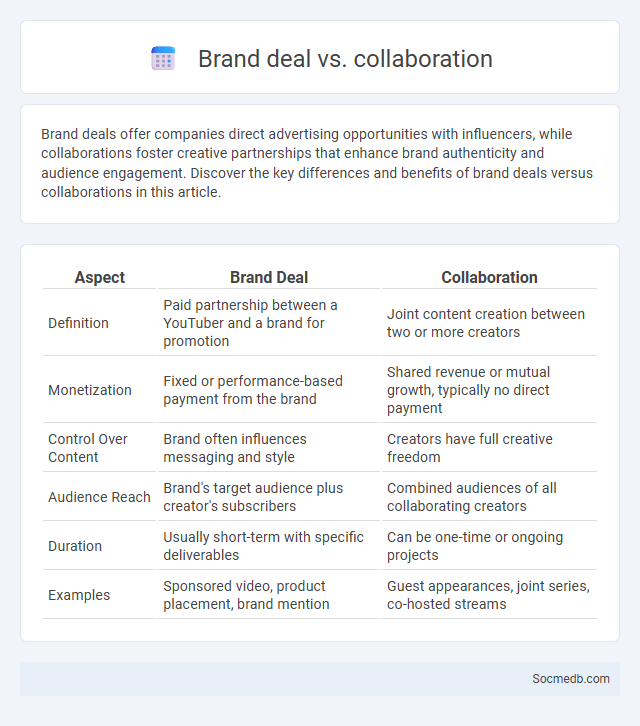
Photo illustration: Brand deal vs Collaboration
Brand deals offer companies direct advertising opportunities with influencers, while collaborations foster creative partnerships that enhance brand authenticity and audience engagement. Discover the key differences and benefits of brand deals versus collaborations in this article.
Table of Comparison
| Aspect | Brand Deal | Collaboration |
|---|---|---|
| Definition | Paid partnership between a YouTuber and a brand for promotion | Joint content creation between two or more creators |
| Monetization | Fixed or performance-based payment from the brand | Shared revenue or mutual growth, typically no direct payment |
| Control Over Content | Brand often influences messaging and style | Creators have full creative freedom |
| Audience Reach | Brand's target audience plus creator's subscribers | Combined audiences of all collaborating creators |
| Duration | Usually short-term with specific deliverables | Can be one-time or ongoing projects |
| Examples | Sponsored video, product placement, brand mention | Guest appearances, joint series, co-hosted streams |
Understanding Brand Deals: Definition and Scope
Brand deals on social media involve partnerships where influencers or content creators promote products or services in exchange for compensation, enhancing brand visibility and consumer engagement. These collaborations vary in scope, ranging from sponsored posts, product placements, and giveaways to long-term ambassador roles that leverage audience trust and authenticity. Understanding the dynamics of brand deals is crucial for maximizing marketing ROI, compliance with advertising regulations, and aligning partnership goals with brand identity and target demographics.
What is a Collaboration? Key Features
A collaboration on social media involves multiple users or brands working together to create and share content, combining their audiences for greater reach and engagement. Key features include co-authored posts, shared analytics, joint branding, and synchronized publishing, enabling both parties to benefit from increased visibility and credibility. Your collaboration efforts can amplify influence and foster authentic connections across diverse communities.
Brand Deal vs Collaboration: Core Differences
A brand deal typically involves a formal agreement where a company pays an influencer or creator for promoting a specific product or service, often with predefined deliverables and compensation terms. A collaboration, on the other hand, centers around a mutual partnership where both parties co-create content or campaigns, sharing creative control and benefits, which can foster longer-term relationships and brand authenticity. Understanding these core differences helps you strategically choose between transactional brand deals or deeper collaborations to enhance your social media presence and engagement.
Advantages of Entering Brand Deals
Entering brand deals on social media significantly boosts a creator's income potential by providing steady revenue streams through sponsored content. These partnerships enhance brand visibility, leveraging the influencer's targeted audience reach to drive sales and increase brand loyalty. Collaborating with reputable brands also elevates the influencer's credibility, attracting further business opportunities and expanding their professional network.
Benefits of Strategic Collaborations
Strategic collaborations on social media amplify your brand's reach by tapping into diverse audiences and leveraging shared expertise. These partnerships enhance content quality and engagement, driving higher organic growth and boosting your campaigns' effectiveness. Your brand gains credibility and new opportunities through authentic collaborations with influencers and industry leaders.
Potential Drawbacks: Brand Deal Challenges
Navigating brand deals on social media can present potential drawbacks such as inconsistent communication, delayed payments, and misaligned expectations between influencers and brands. Your reputation may suffer if contractual obligations are not clearly defined or fulfilled, leading to loss of trust and future opportunities. Ensuring transparency and setting realistic deliverables upfront helps mitigate risks in social media brand partnerships.
Collaboration Pitfalls to Consider
Collaboration pitfalls in social media often stem from unclear communication, misaligned goals, and inconsistent content strategies, which can disrupt audience engagement and brand messaging. Your team must establish clear roles and transparent workflows to avoid duplication of efforts or conflicting posts that confuse followers. Addressing these challenges ensures efficient teamwork and a cohesive presence across social platforms, boosting overall campaign effectiveness.
Choosing the Right Approach: Brand Deal or Collaboration?
Choosing the right approach between a brand deal and a collaboration depends on the campaign goals, target audience, and desired level of creative control. Brand deals typically offer fixed compensation and clear deliverables, making them suitable for straightforward promotions with measurable ROI. Collaborations foster deeper partnerships and co-creation, often enhancing authenticity and long-term brand affinity through shared values and storytelling.
Negotiating Terms: Brand Deal vs Collaboration Essentials
Negotiating terms in social media brand deals requires clear definitions of deliverables, usage rights, and payment structures to ensure mutual benefit. Collaboration essentials emphasize transparency, outlining content ownership, timelines, and exclusivity to avoid conflicts. Precise agreements on performance metrics and content approval processes optimize partnership outcomes and protect brand reputation.
Case Studies: Successful Brand Deals and Collaborations
Successful brand deals on social media often leverage influencer reach and authentic audience engagement to boost visibility and sales. Case studies like Nike's collaboration with influencer Emma Chamberlain highlight a 20% increase in product awareness and a surge in online engagement within weeks. Brands like Glossier also demonstrate the power of micro-influencer partnerships, driving a 35% rise in user-generated content and a measurable increase in conversion rates.
 socmedb.com
socmedb.com